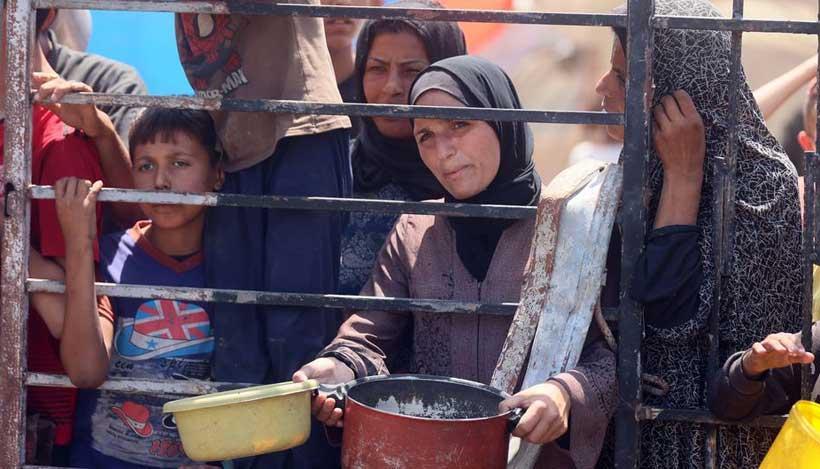By
Batseba Seifu
Africa-Press – Eritrea. In July 2025, the World Health Organization warned that “malnutrition is on a dangerous trajectory in the Gaza Strip, marked by a spike in deaths”—a stark phrase that fails to convey the agony of skeletal children gasping for life in bombed hospitals, or the despair of mothers forced to choose between food and safety for their starving children.
This is not a tragedy. It is a crime.
From the besieged streets of Gaza, to the drought-stricken villages of Tigray, to the corpses of Ethiopian migrants adrift in the Red Sea, hunger is being used as a weapon—and the world is complicit through silence.
Gaza: An Engineered Starvation Machine
In Gaza, starvation is not a byproduct of war—it is the strategy itself.
Israel’s siege, now in its second year of total war, has turned Gaza into a starvation laboratory. UN Special Rapporteur on the right to food, Michael Fakhri, described it bluntly: “Israel has built the most efficient starvation machine you can imagine.” He added: “Israel is starving Gaza. It’s genocide. It’s a crime against humanity. It’s a war crime.”
Fakhri’s repeated warnings—like those of Cassandra in Greek mythology—have fallen on deaf ears: “I have been repeating it and repeating it and repeating it, I feel like Cassandra,” he lamented.
The facts are clear: Gaza’s entire food system has been decimated. Israel has restricted humanitarian aid, bombed agricultural land, destroyed bakeries, and blocked medical supplies. The result is a man-made famine in motion, documented in real time.
Even aid drops—often cited as lifelines—have become cruel performances. As one Gaza resident wrote in Al Jazeera: “Last week, I saw aid dropping from the sky… Neither I nor any of my neighbours had the courage to chase after it because we knew that the moment it hit the ground, a battle would erupt.”
These airdrops, rather than a solution, replicate past failures. In Afghanistan (2001), U.S. aid packages looked similar to cluster bombs, and children were killed mistaking one for the other. In Syria, aid airdrops were captured by ISIS. In Gaza, they fall into chaos or disrepair.
The starvation of Gaza is not incidental. It’s a form of collective punishment and a breach of international humanitarian law—specifically, Article 54 of Additional Protocol I of the Geneva Conventions and Article 8(2)(b)(xxv) of the Rome Statute, which prohibit using starvation as a method of warfare.
Tigray: A Forgotten Famine
Thousands of kilometers away, in Kolla Tembien, Tigray, the fields are scorched and the people are dying—but no satellites beam their suffering to the world.
According to Addis Standard, at least 22 people have died of hunger and over 27,000 livestock have perished due to drought in this war-ravaged region. Local officials and community leaders describe widespread crop failures, withered sesame fields, and collapsing food systems. Acute malnutrition, particularly among children and the elderly, is rising exponentially.
“People are already dying. We are helpless without urgent support,” said Goitom Gebrehaweria, an administrator in Yaqer.
The Tigray Interim Regional Administration (TIRA) promised relief aid following an emergency cabinet meeting on August 4, but as of today, no food, no water, no medical supplies have arrived.
This drought is not merely a natural disaster—it is the legacy of war, blockade, and deliberate neglect. For two years (2020–2022), Ethiopian and Eritrean forces besieged Tigray, deliberately destroying crops, looting food aid, and cutting off humanitarian corridors. The UN and humanitarian agencies documented starvation deaths during the blockade, yet global attention remained scattered and hesitant to invoke the term “genocide.”
The current famine is not separate from the war—it is the continuation of it.
The Eastern Route: Hunger at Sea
For those who attempt escape—like the Ethiopian migrants crossing the treacherous Eastern Route to Yemen—hunger becomes their executioner.
On August 7, the International Organization for Migration (IOM) reported that seven Ethiopian migrants died of hunger and thirst on a broken boat sailing from Bossaso, Somalia to Yemen. The vessel carried 250 people, including 82 children, who endured a week of dehydration, starvation, and terror.
“These people have been through a week of hell on the high seas. They have been exploited, terrified and traumatized,” said Abdusattor Esoev, IOM’s chief of mission in Yemen.
The IOM also recorded over 350 deaths and disappearances along this migration route since January 2025—an astounding number that underscores both the desperation of migrants and the abandonment they face.
These are not economic migrants in the traditional sense. Many are fleeing climate-induced famine, ethnic violence, and a total collapse of state protections. But they rarely become the face of international concern. They vanish nameless, faceless, and forgotten.
A Global Architecture of Hunger and Abandonment
From Gaza to Tigray to the Red Sea, a single thread binds these atrocities: starvation is being weaponized—actively and passively—against racialized and politically marginalized populations.
Blockades in Gaza, drought and indifference in Tigray, trafficked escape routes in the Red Sea. The outcome is the same: preventable death, enabled by policy and silence.
These are not isolated “crises.” They are outcomes of global systems that allow certain populations to be expendable. They are symptoms of an international order in which violations of humanitarian law are selectively enforced and mass starvation is tolerated.
The Cost of Silence
We must stop pretending we didn’t know.
We have satellite images of Gaza’s flattened farms. We have testimonies from Tigray’s starving farmers. We have UN agencies documenting hunger-related deaths in Ethiopia and Yemen. We have enough evidence to prosecute—but not enough political will to intervene.
The world failed Tigray—both during the height of its genocidal war and now, in the face of mounting famine. It is failing Gaza by refusing to hold Israel accountable for systematic starvation. It is failing Ethiopian migrants, who are starving in boats and being buried in unmarked graves.
Instead, this Is What Must Be Done
Lift the blockade on Gaza and ensure immediate, unrestricted humanitarian access.
Recognize the starvation in Gaza and Tigray as war crimes, and open independent international investigations under the Rome Statute.
Deploy emergency food, water, and medical aid to drought-stricken regions of Tigray without delay or political interference.
Establish safe migration corridors and search-and-rescue mechanisms for Ethiopian migrants crossing the Red Sea.
Confront the global double standard that places lesser value on Black, brown, and Muslim lives.
We are not lacking in data. We are not lacking in legal frameworks. We are lacking in moral clarity and the courage to act.
Let it be said: the starvation in Gaza is not inevitable. The famine in Tigray is not natural. The migrant deaths in the Red Sea are not accidents. They are the result of deliberate inaction—a silence that kills.
And unless we break that silence, we too are complicit.
moderndiplomacy
For More News And Analysis About Eritrea Follow Africa-Press







